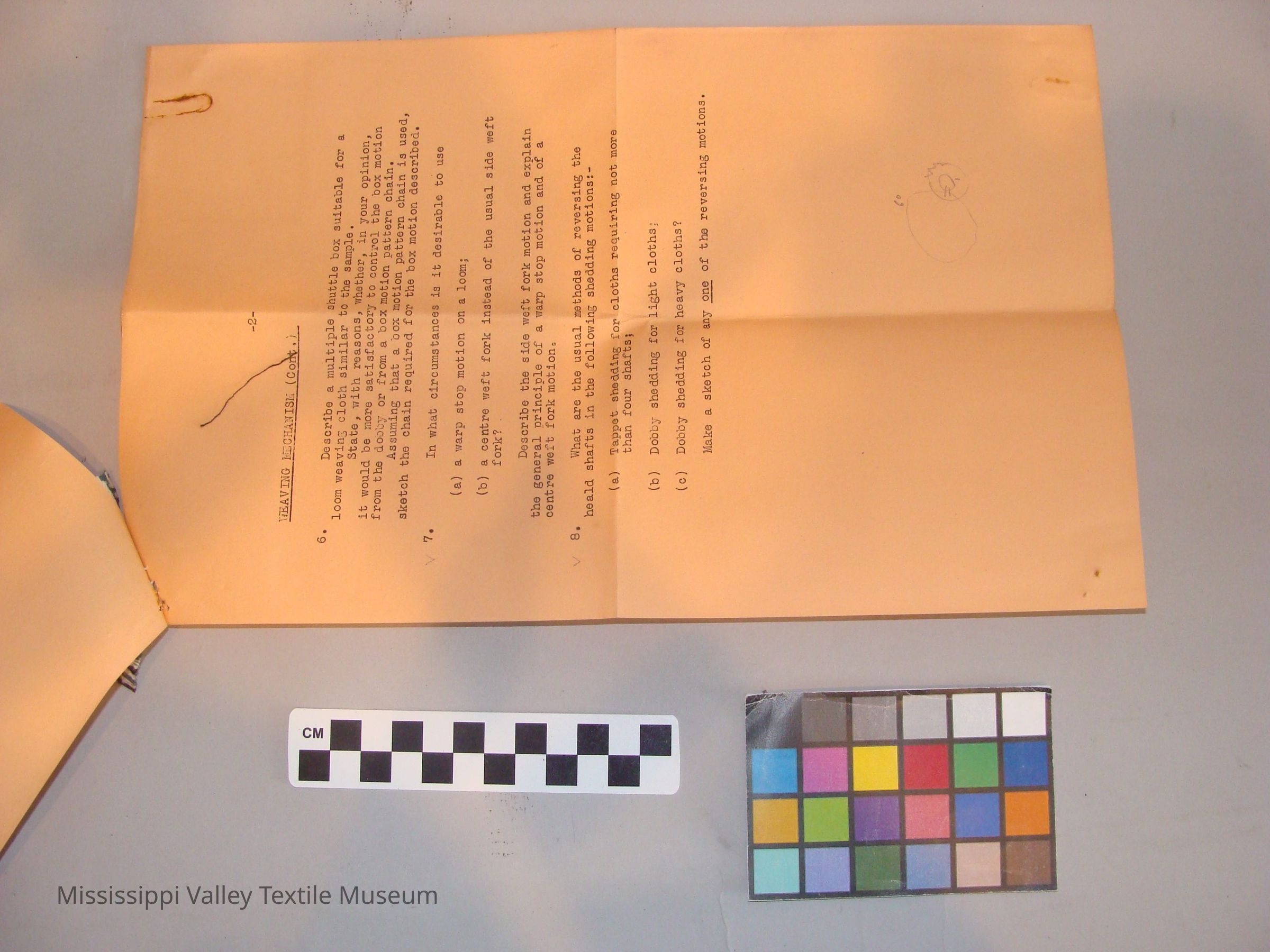Name/Title
Exercise, SchoolEntry/Object ID
1991.05.03.06Scope and Content
2 pages of peach coloured, legal sized paper.
The Victoria University of Manchester
College of Technology
June Sessional Examinations 1939 Session 1938-39
Weaving Mechanism
8 Questions
1 fabric sample, green, black and whiten pattern
Revers; 2 Blank pages
Transcription:
7/M
VICTORIA UNIVERSITY OF MANCHESTER
(FACULTY OF TECHNOLOGY
COLLEGE OF TECHNOLOGY
JUNE SESSION EXAMINATIONS, 1939
SESSlON 193838-39
WEAVING MECHANISM.
Textile Industries. 2nd Ordinary and 1st Year Higher
Friday, 16th June, 1939 9.30 a.m.- 12.30 p.m
Candidates are required to attempt not more than SIX questions. _ _ _ _
Questions-
Explain, with the help of a line sketch, the
action of a cone overpick motion. State its good and bad points and say why it Is not commonly used for looms weaving (a) rayon cloths, to) wide cotton sheeting cloths.
/ 2. What are the reasons for the following
(a) Beginning the shedding dwell before the beginning of the shuttle traverse.
(b) Ending the dwell before the end of the shuttle traverse.
(c) Lifting the inner end of the picker spindle in cone overpick looms.
(d) Using short connecting arms in wide looms.
Criticize any of these common practices.
3. Name any types of cloths for the weaving of which
an automatic cross border dobby is desirable.
Explain the principle of any cross border dobby, including the method of changing over from one pattern to the other.
4. A positive, indirect taking-up motion for a rayon
loom, la arranged, as follows:
The ratchet wheel, which la the change wheel, is compounded with a single worm (equivalent to a wheel of 1 tooth) , which drives a worm wheel of 60 teeth on the take-up roller. If the number of teeth in the ratchet wheel is to be equal to the number of picks per half inch in the cloth, calculate the necessary circumference of the take-up roller allowing 1 1/2 per cent for contraction.
Explain how damage to cloth by friction is minimised in a motion of this kind.
5. Automatic let-off motions are classified as
"negative ''controlled negative", and "controlled positive". What exactly do you understand by these terms?
Explain the principle of any controlled let-off motion and mention any advantages of the type described over alternative motions.
P.T.O.Collection
Textile IndustryCataloged By
Murray, PamLexicon
Nomenclature 4.0
Nomenclature Primary Object Term
Exercise, SchoolNomenclature Sub-Class
Instructional DocumentsNomenclature Class
Documentary ObjectsNomenclature Category
Category 08: Communication ObjectsLOC Thesaurus for Graphic Materials
Education, Textile industry, Tests, ExaminationsSearch Terms
Manchester UniversityLocation
Location
Drawer
D65Room
Collections RoomBuilding
M.V.T.M.Category
PermanentDate
November 7, 2023Location
Container
Archive Box 1Shelf
Shelf 2, Shelf 2Cabinet
Red SideboardRoom
Collections RoomBuilding
M.V.T.M.Category
PermanentMoved By
Whit, ElizabethDate
July 7, 2016Relationships
Related Person or Organization
Person or Organization
Bornet, George M.General Notes
Note
Status: OK
Status By: Cotter, Ellen
Status Date: 2022-06-07Created By
admin@catalogit.appCreate Date
June 25, 2010Updated By
admin@catalogit.appUpdate Date
November 11, 2023
